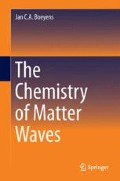Abstract
The development of physical science over the last two millenia is traced from the summary of Lucretius, through the early Christian era, to the transformation into critical science after Copernicus. This revolution saw the birth of physics and chemistry to replace Aristotelian authority and alchemy, guided by the principles formulated by Isaac Newton and John Dalton. The new awareness blossomed into the formulation of a comprehensive theoretical mechanics and the recognition of seventy well-characterized chemical elements to replace the four elements of antiquity.
Access this chapter
Tax calculation will be finalised at checkout
Purchases are for personal use only
Notes
- 1.
Only circles were assumed to reflect heavenly perfection.
References
Lucretius: The Nature of the Universe, English translation by R. Latham. Penguin Books, Harmondsworth (1951)
Sonar, T.: 3000 Jahre Analysis. Springer, Heidelberg (2011)
Boeyens, J.C.A.: Chemical Cosmology. www.springer.com (2010)
Hall, A.R.: The Rise of Modern Science. III. From Galileo to Newton. Collins, London (1963)
Priesner, C., Figala, K.: Alchemie. Beck, München (1998)
Lowry, T.M.: Inorganic Chemistry. Macmillan, London (1922)
More, L.T.: Isaac Newton, p. 664 (1934)
Partington, J.R.: A Text-Book of Inorganic Chemistry, 6th edn. Macmillan, London (1953)
Stewart, A.W.: Recent Advances in Physical and Inorganic Chemistry, 5th edn. Longmans, London (1926)
Kekulé, A.: Lehrbuch der Organischen Chemie. Enke, Erlangen (1861)
Frank, N.H.: Introduction to Electricity and Optics, 2nd edn. McGraw-Hill, New York (1950)
Boeyens, J.C.A.: The Theories of Chemistry. Elsevier, Amsterdam (2002)
Schrödinger, E.: Quantisiering als Eigenwertproblem. Ann. Phys. 79, 489–527 (1926)
Author information
Authors and Affiliations
Rights and permissions
Copyright information
© 2013 Springer Science+Business Media Dordrecht
About this chapter
Cite this chapter
Boeyens, J.C.A. (2013). The Classical Background. In: The Chemistry of Matter Waves. Springer, Dordrecht. https://doi.org/10.1007/978-94-007-7578-7_2
Download citation
DOI: https://doi.org/10.1007/978-94-007-7578-7_2
Publisher Name: Springer, Dordrecht
Print ISBN: 978-94-007-7577-0
Online ISBN: 978-94-007-7578-7
eBook Packages: Chemistry and Materials ScienceChemistry and Material Science (R0)

